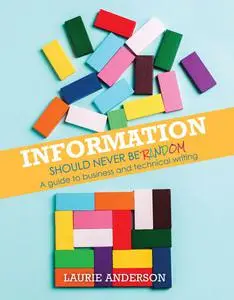Laurie Anderson, "Information Should Never Be Random: A Guide to Business and Technical Writing"
English | ISBN: 1792484887, 9781792484889 | 2021 | 354 pages | PDF | 152 MB
English | ISBN: 1792484887, 9781792484889 | 2021 | 354 pages | PDF | 152 MB
Information Should Never Be Random: A Guide to Business and Technical Writing breaks down that writing process for students so they can capitalize on it and get ahead on the job faster. This book approaches teaching business and technical writing differently than other books. This text separates how information is organized from how the information is delivered to the writer’s audience. This separation makes the application of learning more flexible for any dynamic work setting.
This book takes the lowest common denominator approach and assumes that readers have taken a couple of English composition courses where they learned how to reflect on what they've read and communicated those reflections in writing with well-formed paragraphs with tailored topic sentences. Therefore, Information Should Never Be Random: A Guide to Business and Technical Writing includes small sections with well-defined headings. So readers can decide whether they need to read that section to learn its material or whether they already know it and thus can skim or skip it.
Each chapter/section covers the material, includes an example so students can learn by mimicking it, and offers exercises/review questions at the end of the chapter/section that assists in the application of the concepts covered.
The concepts covered in this text include:
The writing process consists of three stages: prewriting, drafting, revision.
Assistance in audience analysis.
The most common patterns of organizing information.
The various parts of a document that are common, misunderstood, or optional depending on the conditions: introductions, conclusions, abstracts, summaries, tables, and citing other sources' work.
The delivery mechanisms of the three common letterforms, memos for internal communications, and email.
The most common grammar difficulties encountered in business and technical writing.



